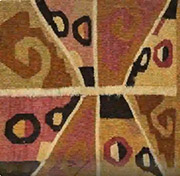Center, Textile Research

IX Jornadas Internacionales de Textiles Precolombinos y Amerindianos / 9th International Conference on PreColumbian and Amerindian Textiles, Museo delle Culture, Milan, 2022
Date of this Version
2024
Document Type
Article
Citation
Published in IX Jornadas Internacionales de Textiles Precolombinos y Amerindianos / 9th International Conference on Pre-Columbian and Amerindian Textiles, Museo delle Culture, Milan, 2022. (Lincoln, Nebraska: Zea Books, 2024)
DOI: 10.32873/unl.dc.zea.1633
Abstract
La convivencia de dos formas de producción textil, organizadas a partir de técnicas y necesidades histórica y culturalmente modeladas, constituyen lo cotidiano en la mayoría de comunidades tejedoras del territorio andino. Ambas modalidades, el telar de cintura de origen prehispánico y el telar de pedal de tipo español, producen tejidos desde lógicas diversas que testimonian sobre aspectos centrales de la vida de las sociedades andinas, en una suerte de diagnóstico socio cultural e histórico. En este artículo se presentan algunas características constantes, así como peculiares, en los patrones textiles del grupo kichwa lamista del piedemonte amazónico, zona montañosa del nororiente peruano. Espacio de alta circulación del recurso algodón y de tejidos, esa región nos invita a indagar en tradiciones regionales más antiguas y posiblemente más extendidas, así como examinar estrategias contemporáneas de producción y circulación. Fuentes históricas, así como material producido durante el trabajo de campo me permitirán presentar un avance que informe sobre contextos históricos y culturales identificados en la producción textil kichwa lamista, para aproximarnos a la construcción de sistemas de relaciones y conectar entornos, sujetos y materialidades en una perspectiva temporal amplia. No fue posible indagar sobre material arqueológico comparativo debido a las condiciones climáticas que no permiten la preservación de tejidos ni otro material orgánico. En los años 2013 y 2022 visité las Comunidades nativas Alto Pucallpillo, distrito de Shanao, provincia de Lamas y Copalsacha, distrito de San José de Sisa, provincia de El Dorado, así como el Centro poblado Tununtunumba, distrito de Chazuta, provincia de San Martín, donde se entrevistó a maestras tejedoras y familias lamistas.
The coexistence of two forms of textile production, organized on the basis of historically and culturally modeled techniques and needs, is a daily occurrence in most weaving communities in the Andean territory. Both systems, the backstrap loom of pre-Hispanic origin and the Spanish pedal loom, produce weavings from distinct logics that bear witness to central aspects of the life of Andean societies, in a sort of socio-cultural and historical diagnosis. This article presents some constant and peculiar characteristics in the textile patterns of the Kichwa lamista group of the Amazonian foothills, a mountainous area in northeastern Peru. An area of high circulation of cotton and textiles, this region invites us to investigate older and possibly more widespread regional traditions, as well as to examine contemporary strategies of production and circulation. Historical sources, as well as materials produced during the fieldwork will allow me to present some advances that inform about the historical and cultural contexts identified in the Kichwa lamista textile production, to approach the construction of systems of relationships and connect environments, subjects and materialities in a broad temporal perspective.It was not possible to investigate comparative archaeological material due to climatic conditions that do not allow the preservation of textiles or other organic material. In 2013 and 2022 I visited the native communities of Alto Pucallpillo, district of Shanao, province of Lamas and Copalsacha, district of San José de Sisa, province of El Dorado, as well as the village of Tununtunumba, district of Chazuta, province of San Martín, where master weavers and lamista families were interviewed.
Included in
American Material Culture Commons, Art and Materials Conservation Commons, Fiber, Textile, and Weaving Arts Commons, Indigenous Studies Commons, Latin American History Commons, Museum Studies Commons, Native American Studies Commons, Other History of Art, Architecture, and Archaeology Commons, Other Religion Commons


Comments
Copyright © 2024 María Elena del Solar.